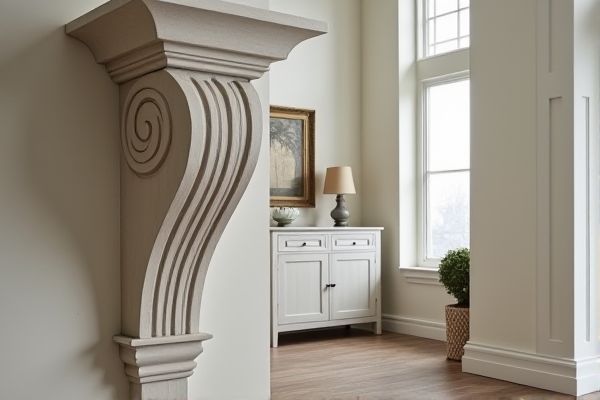
Decorative corbels often feature intricate designs and traditional craftsmanship, adding classic elegance and architectural detail to your space, while modern brackets emphasize sleek, minimalist aesthetics and functionality, complementing contemporary interiors. Explore the full article to discover which option best suits your style and structural needs.
Table of Comparison
| Feature | Decorative Corbels | Modern Brackets |
|---|---|---|
| Design Style | Ornate, classic, traditional | Sleek, minimalistic, contemporary |
| Material | Wood, plaster, resin | Metal, steel, aluminum |
| Functionality | Primarily decorative, some support | Structural support, often decorative |
| Installation | Wall-mounted, requires precise alignment | Wall or shelf-mounted, easier installation |
| Application | Traditional architecture, vintage furniture | Modern interiors, industrial designs |
| Cost | Moderate to high, depending on material and detail | Economical to moderate |
Introduction to Decorative Corbels and Modern Brackets
Decorative corbels are ornamental architectural elements traditionally crafted from wood, stone, or plaster, designed to support weight or serve as elegant accents under shelves, countertops, and rooflines. Modern brackets, by contrast, emphasize sleek, minimalist designs often made from metal or composite materials, prioritizing both structural support and contemporary aesthetics. Both decor elements serve functional purposes while enhancing interior and exterior design styles, with corbels leaning toward classic and vintage appeal and modern brackets aligning with streamlined, industrial looks.
Historical Overview: Decorative Corbels
Decorative corbels have a rich historical background rooted in classical architecture, often found in Gothic, Renaissance, and Baroque styles as ornate supports for balconies, cornices, and arches. These detailed architectural elements were traditionally carved from stone or wood, serving both structural and aesthetic purposes in historic buildings. Your understanding of decorative corbels highlights their enduring appeal as symbols of craftsmanship and architectural heritage.
Modern Brackets: Design and Innovation
Modern brackets showcase cutting-edge design and innovation, blending sleek materials like stainless steel or aluminum with minimalist, geometric forms that complement contemporary architecture. Their functionality often extends beyond support, integrating LED lighting or modular features to enhance both aesthetics and utility. Choosing modern brackets can elevate your space by providing subtle yet impactful structural accents that align with current interior trends.
Key Material Differences
Decorative corbels are traditionally crafted from wood, plaster, or stone, emphasizing intricate carvings and classical aesthetics that complement historic or rustic interiors. Modern brackets typically utilize metal, steel, or engineered composites, offering sleek lines and minimalist designs suited for contemporary spaces. These material choices impact durability, weight support, and visual style, distinguishing decorative corbels' ornate appeal from the streamlined functionality of modern brackets.
Aesthetic Appeal: Classic vs Contemporary
Decorative corbels offer a timeless aesthetic appeal with intricate carvings and traditional designs that enhance classic and rustic interiors, adding a sense of history and craftsmanship. Modern brackets focus on sleek lines, minimalistic shapes, and often use materials like metal or acrylic to complement contemporary and industrial spaces with clean, understated elegance. Your choice between these elements can transform your space by either emphasizing heritage charm or embracing modern simplicity.
Structural Strength and Functional Uses
Decorative corbels often provide substantial structural support, especially in traditional architecture, by bearing weight for shelves, countertops, or roof overhangs. Modern brackets, typically crafted from metal or engineered materials, combine aesthetic appeal with enhanced load-bearing capacity suited for contemporary designs. While corbels emphasize ornamental craftsmanship with reliable strength, modern brackets prioritize minimalism and versatility in supporting various functional elements.
Installation and Maintenance Comparison
Decorative corbels typically require secure wall mounting with heavy-duty anchors to support their often substantial weight, demanding more precise installation compared to modern brackets designed for simpler, wall-screw attachment. Maintenance of decorative corbels, especially those made from wood or resin, involves regular dusting and occasional refinishing or repainting to preserve their intricate details, while modern brackets, frequently constructed from metal or minimalist materials, need minimal upkeep, often limited to wiping for dust and occasional tightening of fasteners. The complexity of installing and maintaining decorative corbels makes them better suited for permanent architectural enhancements, whereas modern brackets offer easy-to-install and low-maintenance solutions for functional support.
Cost Considerations: Budgeting for Corbels and Brackets
Decorative corbels often come with higher price points due to their intricate designs and handcrafted materials, making them a premium choice for enhancing architectural detail. Modern brackets typically offer a more budget-friendly alternative, featuring simpler shapes and mass-produced construction which reduces manufacturing costs. Your decision between corbels and brackets should factor in both upfront expenses and the long-term aesthetic value each option brings to your space.
Best Applications for Each Type
Decorative corbels are best suited for traditional or classic interior designs, providing ornamental support to shelves, mantels, and cabinetry, enhancing architectural details with intricate patterns and craftsmanship. Modern brackets excel in minimalist or contemporary settings, offering sleek, functional support with clean lines ideal for floating shelves or wall-mounted desks where simplicity and strength are essential. Your choice depends on whether you want to highlight stylistic elegance with corbels or prioritize streamlined practicality with modern brackets.
Choosing Between Decorative Corbels and Modern Brackets
Choosing between decorative corbels and modern brackets depends on the architectural style and functional requirements of the space. Decorative corbels often feature intricate designs and traditional materials like wood or stone, adding classic elegance and ornamental value to mantels, shelves, and cabinetry. Modern brackets, typically made from metals or sleek composites, provide minimalist support with clean lines, ideal for contemporary interiors emphasizing simplicity and industrial aesthetics.
 homyna.com
homyna.com